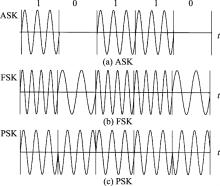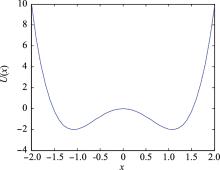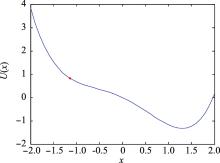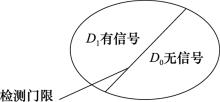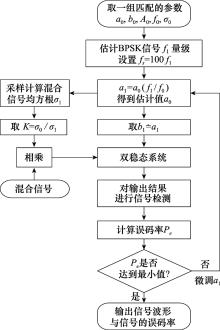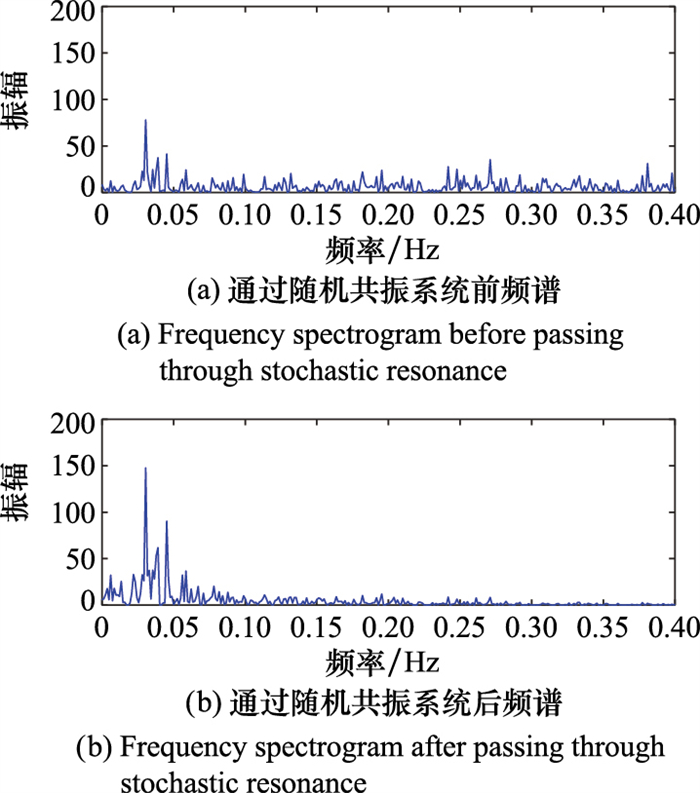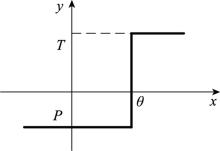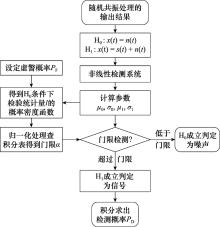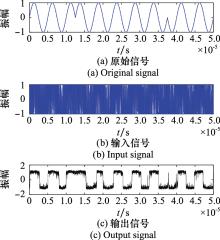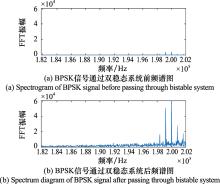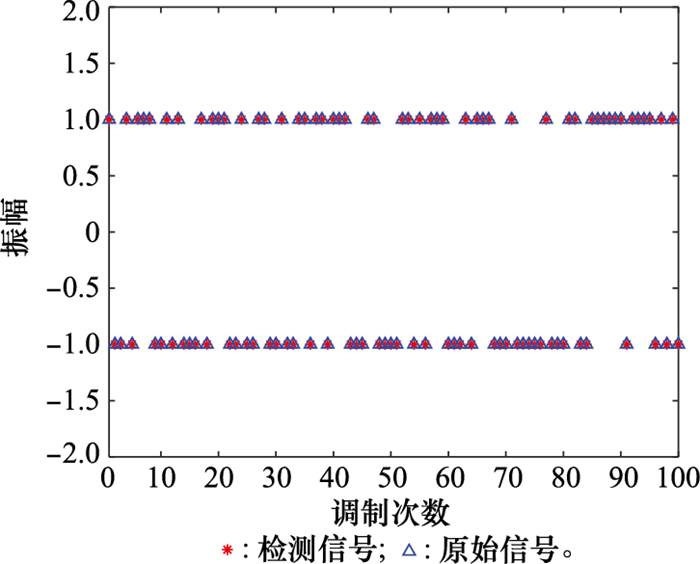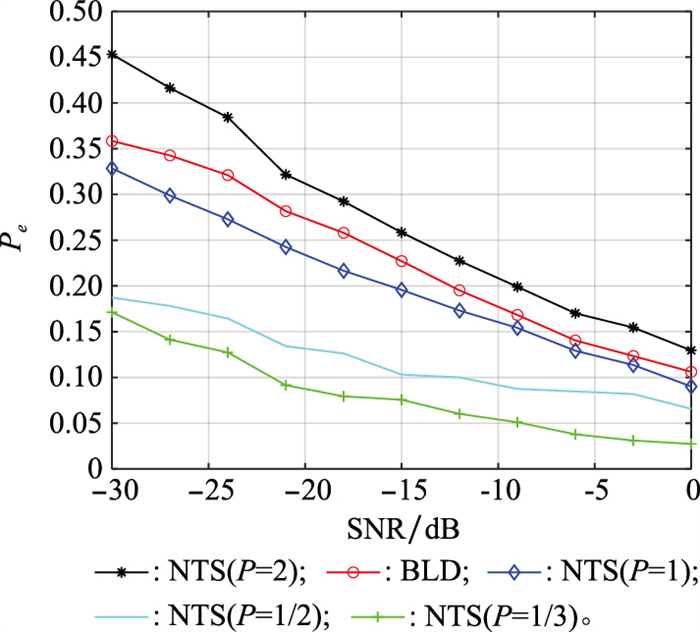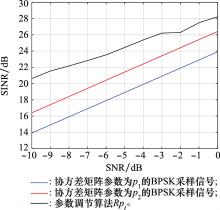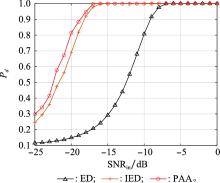Systems Engineering and Electronics ›› 2022, Vol. 44 ›› Issue (7): 2084-2095.doi: 10.12305/j.issn.1001-506X.2022.07.03
• Electronic Technology • Previous Articles Next Articles
Detection algorithm of BPSK signal based on adaptive scale change-bistable stochastic resonance model
Bin LIU1,*, Xiangyu FAN2, Ziwei ZHANG1, Ye ZHANG1
- 1. College of Joint Operations, National Defense University, Beijing 100091, China
2. Air Force Harbin Flight Academy, Harbin 150088, China
-
Received:2021-07-07Online:2022-06-22Published:2022-06-28 -
Contact:Bin LIU
CLC Number:
Cite this article
Bin LIU, Xiangyu FAN, Ziwei ZHANG, Ye ZHANG. Detection algorithm of BPSK signal based on adaptive scale change-bistable stochastic resonance model[J]. Systems Engineering and Electronics, 2022, 44(7): 2084-2095.
share this article
| 1 | EN 302 755 V1.1.1. Frame structure channel coding and modulation for a second generation digital terrestrial television broadcasting system (DVB-T2)[S]. Nice: ESTI, 2009. |
| 2 |
LI Q , LIU Y , PADMARAJU K , et al. A 10-Gb/s silicon microring resonator-based BPSK link[J]. IEEE Photonics Technology Letters, 2014, 26 (18): 1805- 1808.
doi: 10.1109/LPT.2014.2336091 |
| 3 |
BATDALAI S , HIROKI K , NOBUO G . All-optical modulation format conversion from QPSK to symbol rate doubled BPSK using FWM and pulse width compression[J]. Journal of Lightwave Technology, 2017, 35 (19): 4219- 4228.
doi: 10.1109/JLT.2017.2736001 |
| 4 |
HIROKI K , NOBUO G , LAWRENCE R C . All-optical wavelength preserved modulation format conversion from PDM-QPSK to PDM-BPSK using FWM and interference[J]. Journal of Lightwave Technology, 2016, 34 (23): 5505- 5515.
doi: 10.1109/JLT.2016.2620170 |
| 5 |
ZHI T , STOJAN R . Low-noise optical amplification and signal processing in parametric devices[J]. Advances in Optics Photonics, 2013, 5 (3): 318- 384.
doi: 10.1364/AOP.5.000318 |
| 6 |
RADAN S , FRANCESCA P , JOSEPH K , et al. All-optical phase and amplitude regenerator for next-generation telecommunications systems[J]. Nature Photonics, 2010, 4 (10): 690- 695.
doi: 10.1038/nphoton.2010.203 |
| 7 |
FRANCESCO D R , DRAGANA V , KJELD D . Phase regeneration of DPSK signals in a silicon waveguide with reverse-biased p-i-n junction[J]. Optics Express, 2014, 22 (5): 5029- 5036.
doi: 10.1364/OE.22.005029 |
| 8 |
HANS C H M , FRANCESCO D R , MICHAEL G , et al. Phase regeneration of a BPSK data signal using a lithium niobate phase modulator[J]. Journal of Lightwave Technology, 2015, 33 (11): 2189- 2198.
doi: 10.1109/JLT.2015.2408568 |
| 9 | XIE L F , HO I W H , LIEW S C , et al. The feasibility of mobile physical-layer network coding with BPSK modulation[J]. IEEE Trans.on Vehicular Technology, 2017, 66 (5): 3976- 3990. |
| 10 |
ZHOU Y , ZHANG H X , YUAN D F . Differential spatial modulation with BPSK for two-way relay wireless communications[J]. IEEE Communications Letters, 2017, 21 (6): 1361- 1364.
doi: 10.1109/LCOMM.2017.2678466 |
| 11 |
FAOUZI B , ACHREF M , SOFIENE A . Closed-form CRLBs for SNR estimation from turbo-coded BPSK-, MSK-, and square-QAM-modulated signals[J]. IEEE Trans.on Signal Processing,, 2014, 62 (15): 4018- 4033.
doi: 10.1109/TSP.2014.2328328 |
| 12 |
KAI T S , HUANG Y H . SNR estimation based on metric normalization frequency in Viterbi decoder[J]. IEEE Communications Letters, 2011, 15 (6): 668- 670.
doi: 10.1109/LCOMM.2011.040711.110028 |
| 13 |
AMIT K D , HARI K V S , HANZO L . Channel estimation relying on the minimum bit-error-ratio criterion for BPSK and QPSK signals[J]. IET Communications, 2014, 8 (1): 69- 76.
doi: 10.1049/iet-com.2013.0173 |
| 14 | ZHENG D , JULIAN C , NORMAN B . BER analysis of BPSK signals in Ricean-faded cochannel interference[J]. IEEE Trans.on Communications, 2007, 66 (10): 1994- 2001. |
| 15 | IMANI S , GHORASHI S A , BOLHASANI M . SINR maximization in collocated MIMO radars using transmit covariance matrix[J]. Signal Processing, 2016, 11 (9): 128- 135. |
| 16 | FLORIAN E , CHEVREUIL A , LOUBATON P . Blind source separation of convolutive mixtures of non-circular linearly modulated signals with unknown baud rates[J]. Signal Processing, 2012, 9 (2): 715- 726. |
| 17 | HUANG M , HUANG L , SUN W Z , et al. Accurate signal detection for BPSK-OFDM systems in time-varying channels[J]. Digital Signal Processing, 2017, 60 (3): 370- 379. |
| 18 | AHMED E-M . Multiple tone interference of multicarrier frequency-hopping BPSK system for a Rayleigh fading channel with channel estimation errors[J]. Digital Signal Processing, 2010, 20 (8): 869- 880. |
| 19 | CHEE Y M , AHMAD Z S . Adaptive windowed cross Wigner-Ville distribution as an optimum phase estimator for PSK signals[J]. Digital Signal Processing, 2013, 2 (3): 289- 301. |
| 20 |
CARSTEN B . Iterative soft Interference cancellation for sparse BPSK signals[J]. IEEE Communications Letters, 2015, 19 (5): 855- 858.
doi: 10.1109/LCOMM.2015.2408594 |
| 21 | TANG S H , YU Y . Fast algorithm for symbol rate estimation[J]. IEICE Trans.on Communications, 2005, 88 (4): 1649- 1652. |
| 22 |
CHEN H , VARSHNEY P K , KAY S M , et al. Michels, theory of the stochastic resonance effect in signal detection-part I: fixed detectors[J]. IEEE Trans.on Signal Processing, 2007, 55 (7): 3172- 3184.
doi: 10.1109/TSP.2007.893757 |
| 23 |
CHEN H , VARSHNEY P K , KAY S M , et al. Theory of the stochastic resonance effect in signal detection-part Ⅱ: variable detectors[J]. IEEE Trans.on Signal Processing, 2008, 56 (10): 5031- 5041.
doi: 10.1109/TSP.2008.928509 |
| 24 |
LIU X L , LIU H G , YANG J H , et al. Improving the bearing fault diagnosis efficiency by the adaptive stochastic resonance in a new nonlinear system[J]. Mechanical Systems and Signal Processing, 2017, 96, 58- 76.
doi: 10.1016/j.ymssp.2017.04.006 |
| 25 |
WANG J , REN X , ZHANG S W , et al. Adaptive bistable stochastic resonance aided spectrum sensing[J]. IEEE Trans.on Wireless Communications, 2014, 13 (7): 4014- 4024.
doi: 10.1109/TWC.2014.2317779 |
| 26 | QIU Z Y , WANG P , ZHU J . Estimation of both Nyquist zone index and code rate for BPSK radar signal intercepted by Nyquist folding receiver[J]. IET Radar, Sonar & Navigation, 2017, 11 (6): 1652- 1663. |
| 27 |
CHEE H P , KWANG S H , SANG W N . Biased SNR estimation using pilot and data symbols in BPSK and QPSK systems[J]. Journal of Communications and Networks, 2014, 16 (6): 583- 591.
doi: 10.1109/JCN.2014.000104 |
| 28 | LIN L F , YU L , WANG H Q . Parameter-adjusted stochastic resonance system for the aperiodic echo chirp signal in optimal FrFT domain[J]. Communications in Nonlinear Science and Numerical Simulation, 2017, 43 (7): 171- 181. |
| 29 |
CHEN H , VARSHNEY P K , KAY S M . Theory of the stochastic resonance effect in signal detection-part I: fixed detectors[J]. IEEE Trans.on Signal Processing, 2007, 55 (7): 3172- 3184.
doi: 10.1109/TSP.2007.893757 |
| 30 |
CHEN H , VARSHNEY P K , KAY S M . Theory of the stochastic resonance effect in signal detection-part Ⅱ: variable detectors[J]. IEEE Trans.on Signal Processing, 2008, 56 (10): 5031- 5041.
doi: 10.1109/TSP.2008.928509 |
| 31 | SADJAD I , SEYED A G , MOSTAFA B . SINR maximization in colocated MIMO radars using transmit covariance matrix[J]. Signal Processing, 2016, 11 (9): 128- 135. |
| 32 |
LIU J , LI Z . Lowering the signal-to-noise ratio wall for energy detection using parameter-induced stochastic resonator[J]. IET Communications, 2015, 9 (1): 101- 107.
doi: 10.1049/iet-com.2014.0511 |
| [1] | Siqi HUA, Wei ZHAO, Jianye LIU. Background suppression algorithms based on improved filter and image multi-scale transformation [J]. Systems Engineering and Electronics, 2020, 42(8): 1679-1684. |
| [2] | Quan CHEN, Guangcai SUN, Wenkang LIU, Mengdao XING. Highly-squinted MEO SAR focusing based on joint time and doppler scaling [J]. Systems Engineering and Electronics, 2020, 42(2): 309-314. |
| [3] | WANG Hong-wei, FAN Xiang-yu, CHEN You, YANG Yuan-zhi. Recognition method of LFM signals based GSTH transform [J]. Systems Engineering and Electronics, 2016, 38(10): 2228-2234. |
| [4] | LU Zai-qi,FAN Jian-peng,LIU Wei,ZHU Yi-long,FAN Hong-qi. Target maneuver detection algorithm integrated with Doppler measurement [J]. Journal of Systems Engineering and Electronics, 2013, 35(1): 1-8. |
| [5] | XIA Shuang-zhi, LIU Hong-wei, JIU Bo. New approach to determine detection threshold for Bayesian track-before-detect [J]. Journal of Systems Engineering and Electronics, 2012, 34(7): 1305-1311. |
| Viewed | ||||||
|
Full text |
|
|||||
|
Abstract |
|
|||||
